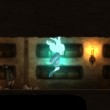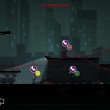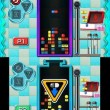Project Temporality Review
Project Temporality candidly sets you on familiar territory. It heavily borrows themes and mechanics from some of the top games in its genre, but not enough to recapture the spark of life found in such classics. As subject 87, you pass through the rooms and hallways of a futuristic space station, manipulating time to solve puzzles--typically involving large buttons and doors. You are overseen by a man whose relentless pursuit of a successful experiment has left the station a nearly abandoned wreck, and subject 87 is seemingly the last among many subjects who failed to live up to expectations.
Project Temporality makes some clear nods to Valve's Portal, but mentioning it in the same breath gives the game far too much credit. The game isn't nearly as clever, and its attempts at humor come off as juvenile and awkward, which gets worse as you near its end. The head of the operation is Admiral Melville, and like GLaDOS, he is an apparently calm tutor, familiarizing you with puzzle-solving mechanics, but he goes completely wacky over the course of the game. But unlike those of his sharp and often sarcastic robotic counterpart, Melville's speeches devolve into didactic rambling and bizarre insults. The laughter I experienced was more a response to the baffling spectacle than to any genuine comedy. It was because of this that I felt exceedingly relieved that the game doesn't include any vocal work. I would feel nothing but pity for the poor soul who had to strain through gritted teeth, "I will eat your children and make a sock puppet out of your face!" with any sort of sincerity.
You would believe the actions of subject 87 to be the catalyst that sparks the change needed to finally end the madness and set things right. Instead, the story spins around you at a distance, occasionally brushing by to remind you that it still exists. Subject 87's actions do nothing for plot progression; any and all attempts to advance the story are performed by other characters as they speak to you via covert messages. The perpetually silent 87 gets pushed along for the ride as the story struggles in vain to try to make the hapless character a significant part of the narrative.
You are likely to find more enjoyment if you just ignore the story and focus on the main reason you would delve into Project Temporality: the puzzle solving. An experimental brain implant grants you the ability to clear challenges by spawning time clones that act out a few moments of your last action. This should sound familiar if you played Ratchet & Clank Future: A Crack in Time, where Clank completed puzzles by creating colored time clones. The simplest challenges have you open a door by holding down a button some distance away. The button may need to be held down to keep the door open, or pressing it could begin a countdown that reaches zero just as you encounter the door.
Project Temporality makes some clear nods to Valve's Portal, but mentioning it in the same breath gives the game far too much credit.

In short, you must be in two places at once. To solve this riddle, you start at or near the door you must pass through and walk toward the button that opens it. When you reach it, you hit rewind and until you're where you need to be, and then create a time clone that follows the exact path to the button and presses it down, allowing you to enter the door. The mechanic excited me when I first saw it executed. I loved watching my past self follow the same path, perhaps smacking against the same barrel I did by mistake, and ending up on the button across a room just as planned. I wanted to wave, jump up, and shout "Thanks for the hand, me!" before moving to the next room, leaving my clone to stand guard, perhaps for an eternity. Naturally, the puzzles get far more complicated than the example I presented. Throughout the game, you face burning lasers, roving platforms, pitfalls, and motion sensors, and passing through them unscathed can take many clones at once.
Solving puzzles requires nonlinear planning, combined with a bit of imagination. Success means knowing exactly where you must be at all times--in the present, the past, and also the future. In one challenge, you must cross a chasm on a floating platform, while also having to move a large wall in order to block a laser placed in such a way as to knock you clear into the abyss. In another, you hold down a button for a door and set up a clone to press a second button, leaving you to pick up a key needed to bypass a room, all within seconds. Both challenges have you using your imagination to place yourself somewhere in the future, whether that means standing on the platform that passes by a laser-blocking wall just in the nick of time, or grabbing a key and escaping by using your ability to create clones.
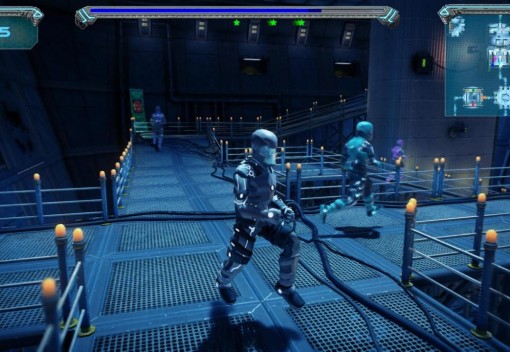
Unfortunately, once you grasp the fundamentals of the puzzles, the fun in solving them withers. Puzzles don't vary much throughout the 14 levels, and never require more than precise timing and pressing a seemingly endless supply of large glowing buttons. The game isn't wholly devoid of challenge, mind. Project Temporality's difficulty progression is organic, and the game provides a few real head-scratchers. The problem is that it gets to the point where you can enter a room and discern exactly how to complete the puzzle just by glancing at the components. This does not originate from a sudden burst of intuition; you've just danced these steps so many times they've started to wear holes in the station's reinforced metal floors. And without those satisfying "Aha!" moments that make puzzle games so engrossing, Project Temporality ends up being a tedious trek from one room to the next, where the only relief comes when you happen upon the portal out of the level.
Project Temporality is also hindered by technical shortcomings that range from repetitive environments to frustrating glitches. The frame rate is noticeably sluggish, a problem exacerbated by floaty mouse aiming. The game recycles objects and set pieces to the point where levels begin to look too similar to one another. You see many of the same signs, workstations, and stasis pods copied and pasted without restraint. Hallways especially feel repetitive after a while. I didn't even want to count how many times I passed the exact same sparking cables and splashes of grime.
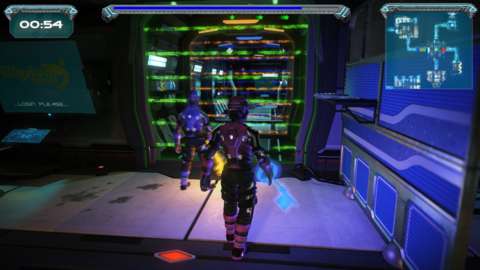
Worst of all are collision glitches, which are evident through the entire game. Any object has the potential to lock you in place with some invisible barrier, or drop you into the floor while you flop about. Granted, you can reverse time by a second or so to remove yourself from the perilous grip of random couches or guardrails, but that's not the point. When you crash to a halt while your attention is locked on a countdown timer, it breaks the pacing. And when the culprit is a half-inch-high bump, it's maddening.
Project Temporality wears its influences on its shiny metal space sleeves. Its effort to imitate is tepid, however, and the stuff of its own concoction that fills the gaps isn't particularly good either. Without the constant glitches, the game would be a mediocre six-hour distraction allowing you to toy with an enjoyable time-bending mechanic. The shallow story and the general awkwardness of its delivery, not to mention Project Temporality's inability to lead the protagonist without a leash, however, prevent the game from being worth the time.




